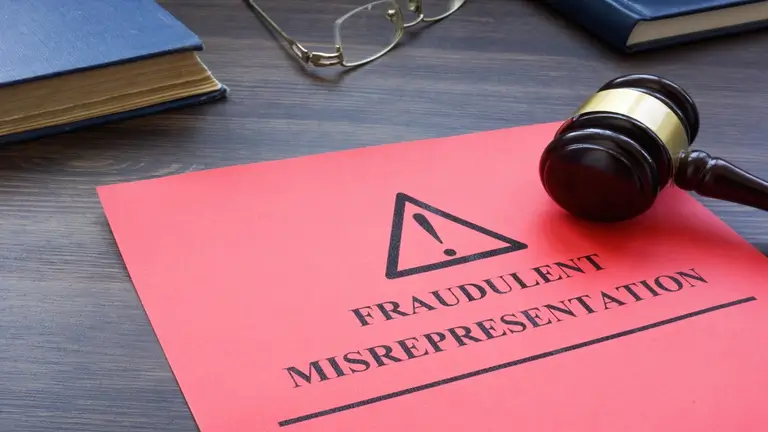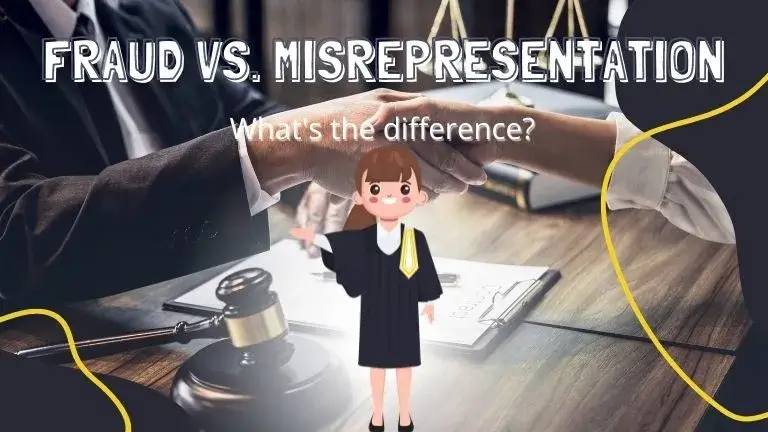Nowadays, everyone is scammed in some way. Some people experience personal or some experience professional fraud.
The difference between fraud and misrepresentation is the difference of intention.
Most parties who enter into a contract do so with good intentions, and there are situations when people or businesses deceive others intentionally or make false statements to make a deal happen.
When a party accepts an offer to supply products or services while being aware that they would be unable to fulfill their responsibilities, it is considered fraud.
Whereas when a party unintentionally causes damage to another party is known as misrepresentation.
Let’s begin by reading the definitions of the two terms:
Table of Contents
Fraud

Fraud is a deceitful act or series of acts carried out to benefit the culprit.
There are many different sorts of fraud, including credit card fraud, online banking fraud, bankruptcy fraud, and tax fraud, among many others.
A single group or company can carry out illegal activities.
Fraud is performed by hiding the truth, removing important information, or making false statements.
These actions are taken in an effort to gain, which would not be possible without engaging in fraudulent behavior.
Fraudsters have an advantage over victims because they have access to information that the victim does not, which allows them to deceive businesses or individuals.
They trick their victim into giving them something valuable in exchange. In other words, the criminal purposefully misrepresents a material fact.
Someone who commits fraud is referred to as a fraudster.
Types Of Fraud
1. Spoofing or Phishing

This sort of friendly fraud involves sending the victim an email claiming to be from a government official or another well-known person under false identities.
The email requests the recipient’s personal information, connects them with a fake website, and then steals user personal information.
2. Credit/Debit Card Fraud

Typically, fraudsters utilize social engineering techniques to obtain a user’s debit or credit card information.
The card will then be used for online purchases by the fraudsters.
3. Lottery Fraud

Fraudulent lottery promotions frequently mislead users.
By subscribing to an illegal lottery program, users tend to lose money after buying lottery tickets.
4. Identity Theft

In this kind of fraud, the criminal portrays himself as another person to open an account using that person’s details.
Organizations have a very limited chance of catching criminals during this phase.
Misrepresentation

A false statement of fact or the law is a misrepresentation.
Misrepresentation of a material fact is an element of fraud.
The purpose of a false misstatement is to trick another person.
The person making the representation knows that it is partially or completely untrue.
A misleading statement of a key fact made by one party that influences the other party’s decision to enter into a contract is a misrepresentation.
In such a contract dispute, the misrepresented is made the accused, and the wronged party is made the claimant.
For instance, a car salesperson lies about the vehicle’s mileage during a private transaction.
The valuation, which a potential buyer could perceive as vital information about the vehicle, is false and has been deceptively conveyed.
Types Of Misrepresentation
There are three basic types of misrepresentation:
- Fraudulent misrepresentation
- Negligent misrepresentation
- Innocent misrepresentation
1. Innocent Misrepresentation
One of the three types of misrepresentation that are known in contract law is innocent misrepresentation.
Basically, it is a misstatement that was made by someone with a valid cause to believe that it was true.
Examples of innocent misrepresentation include a supplier supplying damaged goods to the customers without knowing it.
2. Fraudulent Misrepresentation

A false statement made by one party to persuade another to sign a contract is fraudulent misrepresentation.
For instance, one party might tell another that a piece of land in Houston is situated in a region where oil drilling has just begun, even though they are aware that this is inaccurate.
If the land is bought on the basis of misleading information, the offending person is responsible for fraudulent misrepresentation.
3. Negligent Misrepresentation

A non-fraudulent kind of misrepresentation is negligent misrepresentation, which occurs when the defendant makes a false statement without taking reasonable care to verify its truth.
For instance, if an auditor knows that one of its reports will be used by a client to obtain a bank loan, the firm may be held accountable for improper misrepresentation if the report contains inaccurate information about the client’s company.
Differences Between Misrepresentation and Fraud

The key differences between fraud and misrepresentation are given below:
The first difference between fraud and misrepresentation is that a material fact that is knowingly misstated is fraud.
While misrepresentation is a genuine representation of a false statement that was believed to be real but was later proven to be false.
Another difference between misrepresentation and fraud is that fraud is committed with the intent to deceive the other person, whereas misrepresentation is not.
In fraud, the wronged party has the right to file a lawsuit, but not in misrepresentation.
Section 17 of the Indian Contract Act of 1872 defines fraud while Section 18 defines misrepresentation.
The defense that the other party having the ability to learn the truth cannot be used by the person that made a fraudulent statement, but it may be used in cases of misrepresentation.
What are the Differences Between Fraud and Misrepresentation?
Highlighting the key differences between fraud and misrepresentation in the following table:
| Fraud | Misrepresentation |
| Fraud is defined as deceiving someone knowingly by one party to persuade the other party to sign the contract. | Misrepresentation is the act of making an innocently false statement in an effort to convince another party to sign a contract. |
| The Indian Contract Act of 1872 has a section 2 (17) that deals with fraud. | Section 2 (18) of the Indian Contract Act of 1872 defines misrepresentation. |
| The harmed person is entitled to make a damage claim. | The party who was wronged cannot demand compensation from the offending party. |
| Fraud is the intentional attempt to deceive another party. | The purpose of misrepresentation is to unintentionally deceive the other party. |
Conclusion
The main difference between fraud and misrepresentation is whether the party making the statement of facts considers it to be truthful or not.
In fraud, the intent to deceive is essential. While misrepresentation of material fact is a decision by one party that has an impact on the other party’s choice to enter into a contract.
Read more: What is the Difference Between Evaporation and Condensation?

